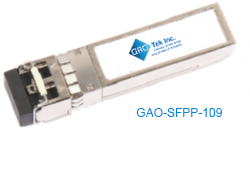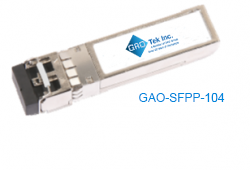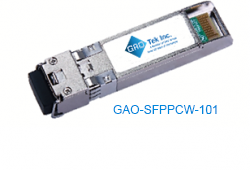Description
Overview:
This 10 Gigabit 1310nm SFP+ Transceiver is used with single mode optical fiber to reach up to 1.24 miles (2km) transmission distance. This SFP+ (enhanced small form-factor pluggable) Transceiver has a FP (Fabry-Perot) type transmitter and a PIN type receiver. This SFP+ transceiver is a Class 1 Laser safety product comply with US FDA regulations and complaint with electrical interface SFF-8431.
Key Features:
- 1310nm FP transmitter
- Up to 1.24 miles (2km) transmission distance
- PIN photo-detector
- Single 3.3V power supply
- Duplex LC connector
-
- 2-wire serial communication protocol
- Metal enclosure, for lower EMI
- Electrical interface compliant to SFF-8431
- management specifications compliant with SFF 8472
- Power dissipation < 1.5W
- unique enhanced digital diagnostic monitoring interface
- Case operating temperature range from 23 °F to 158 °F (-5°C to 70°C)
Technical Specifications:
| Protocol | 2-Wire Serial communication Protocol |
| Working Range | Up to 1.24 miles (2km) |
| Memory | 256-byte memory map in EEPROM |
| Standards | SFF-8472, SFF-8431 and SFF-8432.
RoHS compliant. |
| Data rate | 10Gb/s |
| Wavelength | 1310nm |
| Transmitter | FP |
| Receiver | PIN |
| Connector | LC |
| Transmitter output optical Power | -8.2 dBm to -0.5 dBm |
| Receiver Sensitivity | -14.4 dBm |
| Receiver Input Saturation Power | 0.5 dBm |
| Supply Voltage | 3.3V |
| Dimensions | 2.3in x 0.54in x 0.49in (L 58.4mm x W13.7mm x H 12.6mm) |
| Transmitter Input Differential Impedance | 100Ω |
| Storage Temperature | -40 °F to 185 °F (-40°C to 85°C) |
| Case Operating Temperature | 23 °F to 158 °F (-5°C to 70°C) |
Additional Information:
Applications
Ideal to be used on applications such as
- 10GBASE-LR/LW 10G Ethernet
Ordering Information:
| Product ID | Media | Wavelength | Transmission Distance | Temperature Range | Supply Current |
| GAO-SFPP-109 | Single-mode fiber | 1310nm | 1.24miles (2km) | 23 °F to 158 °F (-5°C to 70°C)
|
300mA |
Test Pattern:
- Measured with a PRBS 231 -1 and BER<10-12 @ data rate @10.325Gb/s:
PRBS31 test pattern represents a pseudorandom binary sequence with a repetition period of 231 -1. The sequence is defined in IEEE STD 802.3.ae
BER<10-12 test represents bit error rate testing provides a measurable and useful indication of the performance of the system
- 20 – 80 % Measured with Module Compliance Test Board and OMA test pattern.
Digital Diagnostics Functions:
- GAOTek GAO-SFPP-109 transceiver support the 2-wire serial communication protocol as defined in the SFP MSA1.
- Additionally, GAOTek SFP+ Transceivers provide a unique enhanced digital diagnostic monitoring interface which allows real-time access to device operating parameters such as transmitter optical power, receiver optical power, transceiver temperature, transceiver supply voltage and laser bias current. It defines an alarm system and warning flags, which alerts the end users when particular operating parameters are outside of a factory set normal range.
- Standard SFP+ Serial id provides access to identification information that describes the transceiver’s capabilities, standard interfaces, manufacturer and other information.
- SFP+ MSA defines a 256-byte memory map in EEPROM that is accessible over a 2 wire serial interface at the 8 bit address 1010000X (A0h).
- The operating and diagnostics information is monitored and reported by a Digital Diagnostics Transceiver Controller (DDTC) inside the transceiver, which is accessed through a 2-wire serial interface. The memories are organized as a series of 8-bit data words that can be addressed individually or sequentially
Electrical characteristics:
| Parameter | Symbol | Min | Type | Max | Unit | Note |
| Transmitter | ||||||
| Input Differential Impedance | Rin | 100 | Ω | |||
| Single ended data input swing | Vin, pp | 180 | 700 | mV | ||
| Transmit Disable Voltage | VD | Vcc–1.3 | Vcc | V | ||
| Transmit Enable Voltage | VEN | Vee | Vee+ 0.8 | V | ||
| Transmit Disable Assert Time | 10 | us | ||||
| Receiver | ||||||
| Differential data output swing | Vout,pp | 300 | 850 | mV | ||
| Data output rise time | tr | 30 | ps | |||
| Data output fall time | tf | 30 | ps | |||
| LOS Fault | VLOS fault | Vcc–1.3 | VccHOST | V | 1 | |
| LOS Normal | VLOS norm | Vee | Vee+0.8 | V | 1 | |
| Power Supply Rejection | PSR | 100 | mVpp | 2 |
Notes:
- Loss of Signal is LVTTL. Logic 0 indicates normal operation; logic 1 indicates no signal detected.
- Receiver sensitivity is compliant with power supply sinusoidal modulation of 20 Hz to 1.5 MHz up to specified value applied through the recommended power supply filtering network.
Optical Characteristics:
| Parameter | Symbol | Min | Type | Max | Unit |
| Transmitter | |||||
| Output Optical Power | POUT | -8.2 | 0.5 | dBm | |
| Optical Wavelength | λ | 1260 | 1310 | 1355 | nm |
| Optical Extinction Ratio | ER | 3.5 | dB | ||
| Output Eye Mask | IEEE 802.3ae requirements | ||||
| Transmitter and Dispersion Penalty | TDP | 3.2 | dB | ||
| RIN | RIN | -128 | dB/Hz | ||
| Spectral Width (-20dB) | σ | 0.4 | nm | ||
| Receiver | |||||
| Receiver Sensitivity | RSENS | -14.4 | dBm | ||
| Wavelength Range | λC | 1270 | 1610 | nm | |
| Input Saturation Power (Overload) | Psat | 0.5 | dBm | ||
| LOS Assert | LOSA | -30 | dBm | ||
| LOS De -Assert | LOSD | -17 | dBm | ||
| LOS Hysteresis | 0.5 | 1.0 | dB | ||
PIN Out Diagram:

PIN Descriptions:
| Pin | Symbol | Name/Description | Note |
| 1 | VEET | Transmitter Ground (Common with Receiver Ground) | 1 |
| 2 | TFAULT | Transmitter Fault | 2 |
| 3 | TDis | Transmitter Disable. | 3 |
| 4 | SDA | 2-wire Serial Interface Data Line | 4 |
| 5 | SCL | 2-wire Serial Interface Clock Line | 4 |
| 6 | MOD_ABS | Module Absent. Grounded within the module | 5 |
| 7 | RS0 | Rate Select 0 | 6 |
| 8 | LOS | Loss of Signal indication. Logic 0 indicates normal operation | 7 |
| 9 | RS1 | No connection required | 1 |
| 10 | VEER | Receiver Ground (Common with Transmitter Ground) | 1 |
| 11 | VEER | Receiver Ground (Common with Transmitter Ground) | 1 |
| 12 | RD- | Receiver Inverted DATA out. AC coupled | |
| 13 | RD+ | Receiver Non-inverted DATA out. AC coupled | |
| 14 | VEER | Receiver Ground (Common with transmitter Ground) | 1 |
| 15 | VCCR | Receiver power Supply | |
| 16 | VCCT | Transmitter Power supply | |
| 17 | VEET | Transmitter Ground (Common with receiver Ground) | 1 |
| 18 | TD+ | Transmitter Non-Inverted DATA in. AC Coupled. | |
| 19 | TD- | Transmitter Inverted DATA in.AC Coupled. | |
| 20 | VEET | Transmitter Ground | 1 |
Notes:
- Circuit ground is internally isolated from ground.
- TFAULT is an open collector or drain output.
- It should be pulled up with a 4.7k -10k ohms resistor on the host board if intended for use.
- Pull up voltage should be between 2.0V to Vcc +0.3V.
- High output indicates a transmitter fault caused by either the TX bias current or the TX output power exceeding the preset alarm thresholds.
- Low output indicates normal operation. In the low state output is pulled to <0.8V
- Laser output disabled when it is open or TDis > 2.0V, enabled on TDis < 0.8V.
- Should be pulled up with 4.7kΩ to 10kΩ on host board to a voltage between 2.0V and 3.6V.
- MOD_ABS pulls the line low, to indicate the module is plugged in.
- Internally pulled down as per SFF-8431.
- Loss of signal (LOS) is open collector output.
- It should be pulled up with 4.7 kΩ to 10 kΩ on host board to a voltage between 2.0V and 3.6V.
- Logic 0 indicates normal operation.
- Logic 1 indicates loss of signal.
Mechanical Specifications:
Improved Pluggable form factor specification Comply to SFF-8432

Host – Transceiver Interface Block Diagram:

Regulatory Compliance:
| Feature | Reference | Performance |
| Laser Eye Safety | FDA 21CFR 1040.10, 1040.11 IEC/EN 60825-1,2 | Class 1 laser product |
| Component Recognition | IEC/EN 60950, UL | Compatible with standards |
| ROHS | 2002/95/EC | Compatible with standards |
| Electrostatic discharge(ESD) | IEC/EN 61000-4-2 | Compatible with standards |
| EMC | EN61000-3 | Compatible with standards |
| Electromagnetic Interference(EMI) | FCC Part 15 Class B EN 55022 Class B (CISPR 22A) | Compatible with standards |



